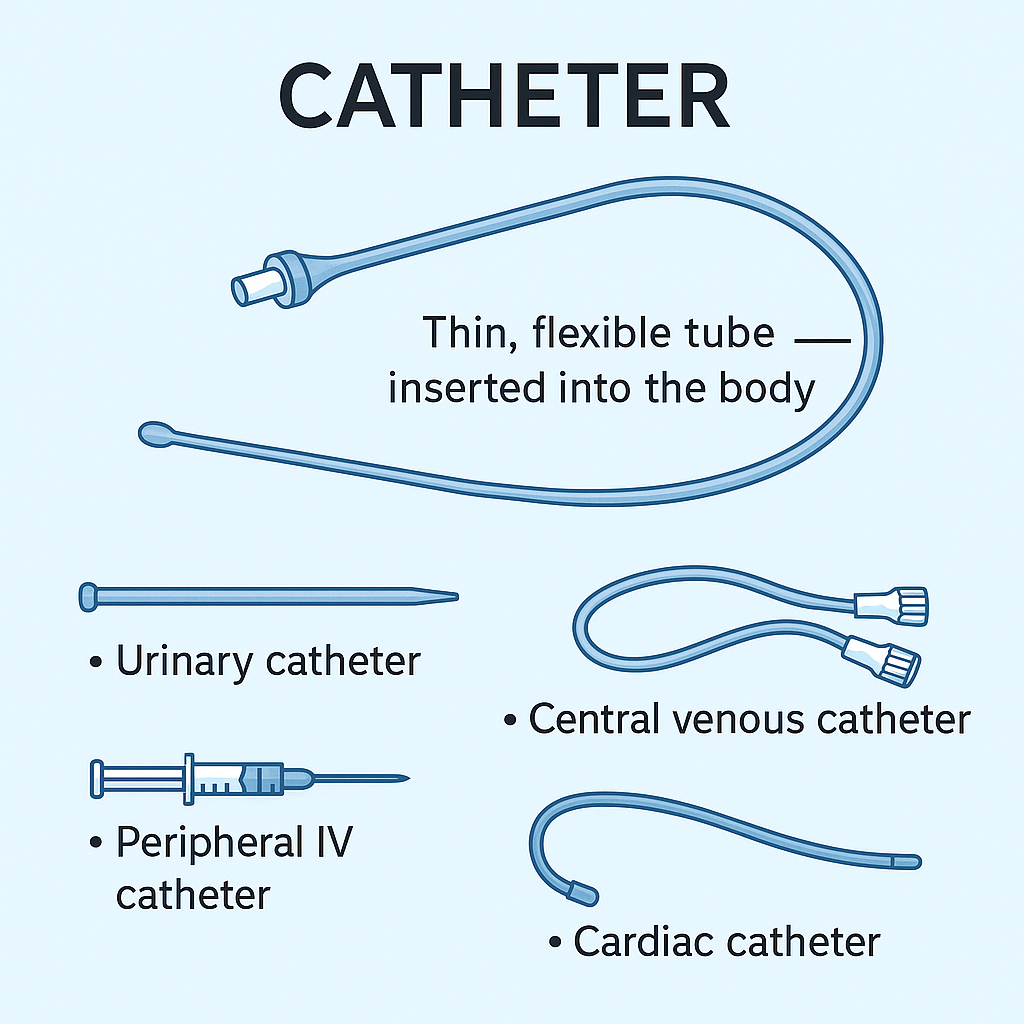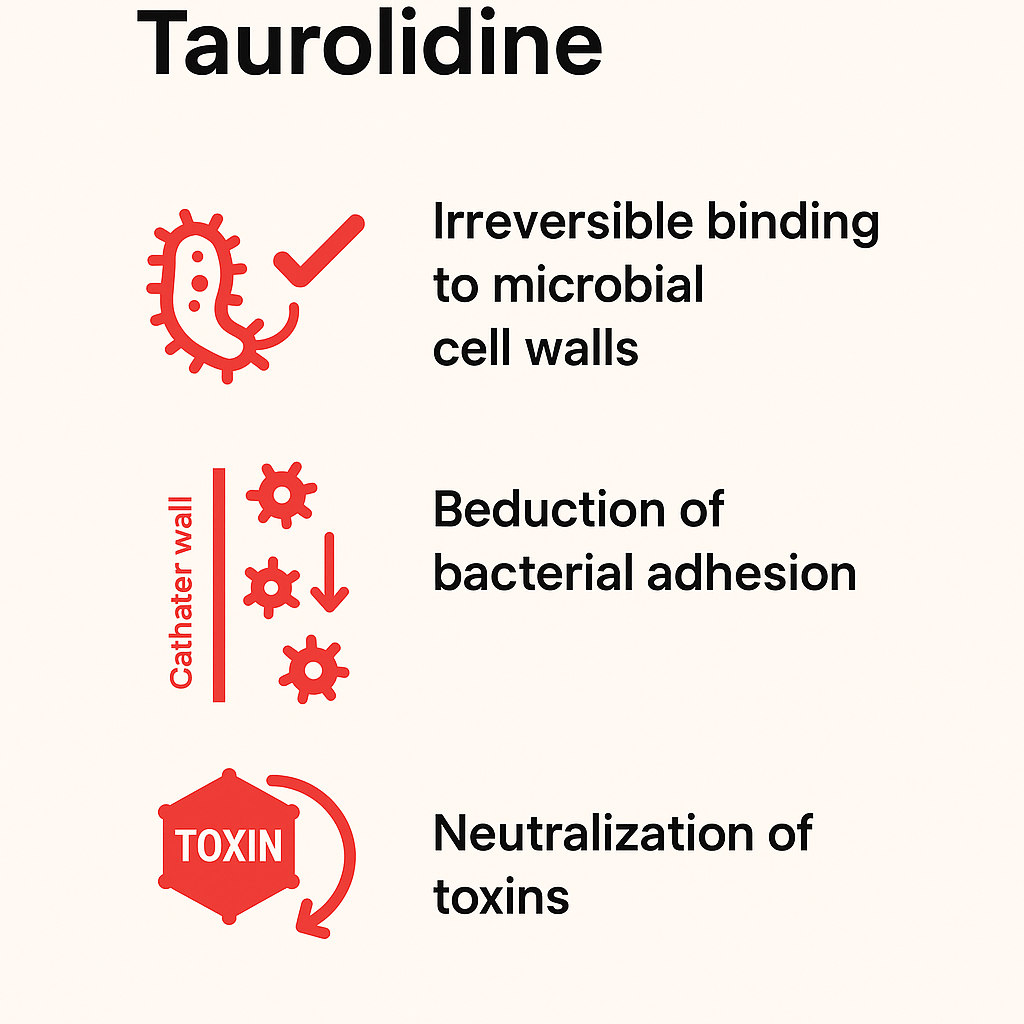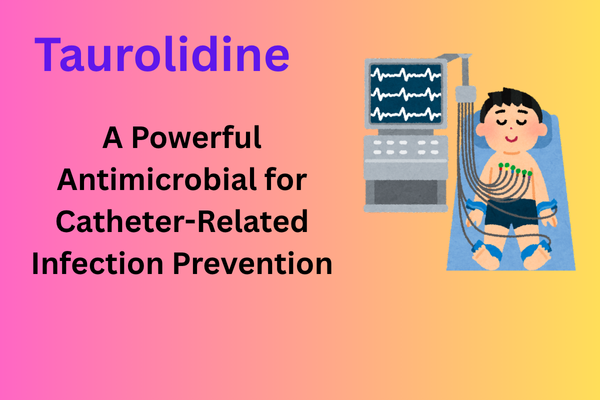Table of Contents
Introduction :
Taurolidine is a broad-spectrum antimicrobial agent that is gaining attention for its role in preventing catheter-associated infections. Approved by the US FDA on November 15, 2023, as part of the combination product Defencath (taurolidine and heparin), this compound has shown promising results in reducing infections associated with central venous catheters (CVCs).
Catheter-associated bloodstream infections (CRBSIs) pose serious risks to patients receiving long-term intravenous therapy. Taurolidine provides a novel solution by not only targeting a broad range of pathogens but also by reducing microbial adhesion and inactivating bacterial toxins.
What is Taurolidine?
It is a derivative of the amino acid taurine and is used in Europe for its antimicrobial and anti-inflammatory properties. It exists as a non-antibiotic antimicrobial agent, meaning it works differently from traditional antibiotics and is less likely to cause microbial resistance.
It is commonly formulated as a catheter lock solution, often with heparin or other anticoagulants, to maintain catheter patency while preventing microbial colonization.
Types of Catheter :

What is a Central Venous Catheter (CVC)?
A central venous catheter (often simply called a central line) is inserted into a large vein – usually in the neck, chest, or groin – and is used for:
• Long-term drug administration (e.g., chemotherapy)
• Dialysis
• Blood sampling
• Parenteral nutrition
A catheter lock solution is a sterile liquid that is placed (injected) into the lumen (inside) of a catheter – particularly a central venous catheter (CVC) – during use to prevent:
1. Infection
2. Blood clotting (occlusion)
FDA Approval of Defencath :
On November 15, 2023, the U.S. Food and Drug Administration approved Defencath, a combination product containing taurolidine and heparin, for the prevention of catheter-related bloodstream infections in patients receiving hemodialysis through central venous catheters.
The approved formulation contains:
- Taurolidine 40.5 mg
- Heparin 3000 units per 3 mL
This combination is designed to lock the catheter between dialysis sessions, providing both antimicrobial protection and anticoagulation.
Mechanism of Action of Taurolidine :
The mechanism of action is diverse and nonspecific, making it effective against a wide range of microorganisms, including:
• Gram-positive bacteria
• Gram-negative bacteria
• Mycobacteria
• Some fungal species
Key mechanistic features:
1. Irreversible binding to microbial cell walls–
Taurolidine and its active methylol metabolites bind irreversibly to components of the microbial cell wall. This binding disrupts the structural integrity of the cell wall, leading to cell lysis and death.
2. Reduction of bacterial adhesion –
It prevents pathogens from adhering to biological surfaces, including catheter walls and mammalian tissues. This reduces the risk of biofilm formation, which is a major cause of chronic infection.
3. Neutralization of toxins –
It can neutralize bacterial endotoxins and exotoxins, thereby reducing inflammation and tissue damage.
This multi-targeted, non-antibiotic mechanism makes taurolidine a powerful option for patients at high risk of infection, particularly where antibiotic resistance is a concern.

Clinical Use: Catheter Lock Solution
Taurolidine is primarily used as part of a catheter lock solution to prevent catheter-related infections. In this application, a small amount of the taurolidine-heparin solution is instilled into the catheter lumen after use and left in place between treatments.
Typical Dosage:
- 3000 units of Heparin + 40.5 mg of Taurolidine per 3 mL
This solution is not administered intravenously but remains in the catheter until the next dialysis or treatment session, at which point it is aspirated and discarded.
Benefits of Defencath in Clinical Settings :
✅ Broad-Spectrum Activity
Effective against a wide range of bacteria and fungi without promoting resistance.
✅ Non-Antibiotic Mechanism
Reduces the risk of antimicrobial resistance and can be used in patients already on antibiotics.
✅ Biofilm Prevention
Inhibits microbial adherence and biofilm formation—a major factor in persistent catheter infections.
✅ Toxin Neutralization
Improves patient outcomes by reducing toxin-mediated inflammation and septic reactions.
✅ Safe and Well-Tolerated
Taurolidine has been shown to have a good safety profile in long-term use.
Why Defencath is a Game-Changer ?
Traditional antibiotics often fall short in preventing catheter-related infections due to biofilm formation and antibiotic resistance. Taurolidine addresses both challenges by:
- Disrupting microbial cell walls via irreversible methylol binding.
- Inhibiting colonization and toxin production.
- Maintaining catheter integrity without systemic side effects.
With its FDA approval as part of Defencath, taurolidine is now positioned as a frontline defense in infection control protocols for dialysis and oncology patients.
Taurolidine vs. Antibiotics: Key Differences
| Feature | Taurolidine | Traditional Antibiotics |
| Mechanism | Non-specific, cell wall damage | Specific molecular targets |
| Resistance | Low likelihood | High risk with prolonged use |
| Systemic Effects | Minimal (local use) | Systemic side effects |
| Biofilm Disruption | Strong | Limited |
| Toxin Neutralization | Yes | No |
Side Effects and Safety Profile :
Defencath has shown a favorable safety profile, especially when used as a catheter lock solution. Common observations include:
- Local irritation (rare)
- Mild anticoagulant-related effects (due to heparin)
- Minimal systemic absorption
Storage and Handling :
- Store at controlled room temperature.
- Protect from direct sunlight.
- Do not use if solution is cloudy or shows particulate matter.
- Once opened, use immediately and discard any unused portion.
Precautions :
- Avoid in patients with allergy to taurolidine.
- Do not inject systemically – for catheter lock use only.
- Use with caution in patients with bleeding disorders (especially when combined with heparin).
- Limited safety data in pregnancy, breastfeeding, children, and elderly – use only if necessary.
- Monitor closely in renal or liver impairment, especially in off-label uses.
Drug Interactions :
- Heparin (in Defencath) increases bleeding risk when used with:
- Antiplatelets (aspirin, clopidogrel)
- Anticoagulants (warfarin, apixaban)
- NSAIDs (ibuprofen, naproxen)
- Avoid mixing with other catheter lock solutions unless compatibility is confirmed.
- No major interactions with systemic antibiotics, but co-use may mask infection signs.
Conclusion:
Taurolidine is not just an antimicrobial – it is a multifunctional infection control agent with applications that go beyond traditional antibiotics. With FDA approval in 2023 in DefenCath, the medical community now has a powerful tool to reduce catheter-associated infections, reduce biofilm formation, and protect vulnerable patients from serious complications.
As antibiotic resistance continues to challenge healthcare systems, agents like Taurolidine offer a much-needed alternative approach – effective, safe, and resistance-proof.
FAQs
1. What is Taurolidine used for?
2. How does Taurolidine work?
3. Is Defencath safe?
4. What microorganisms does Taurolidine work against?
5. Can Defencath cause antibiotic resistance?
Disclaimer: This blog post is for informational purposes only and does not constitute medical advice. Always consult a qualified healthcare professional before making any medical decisions.

